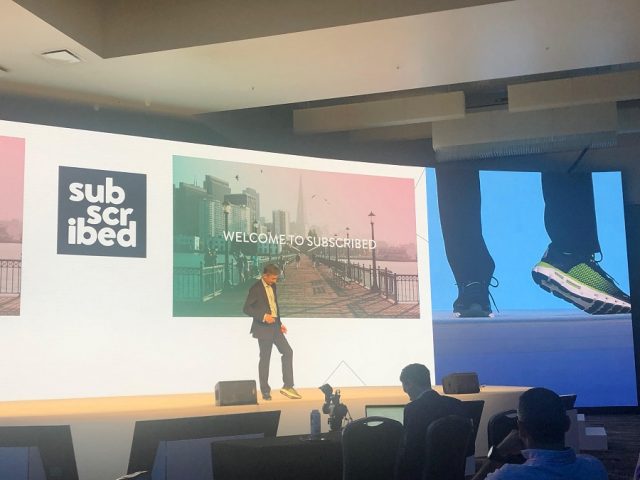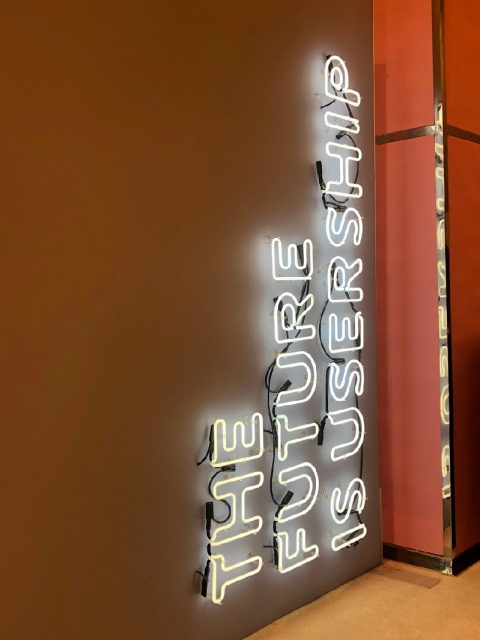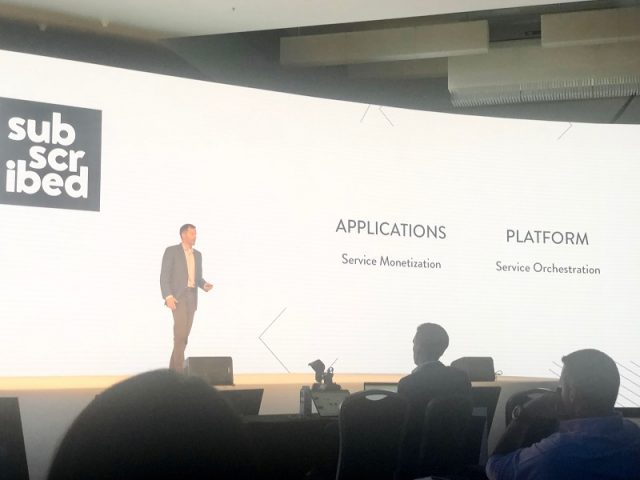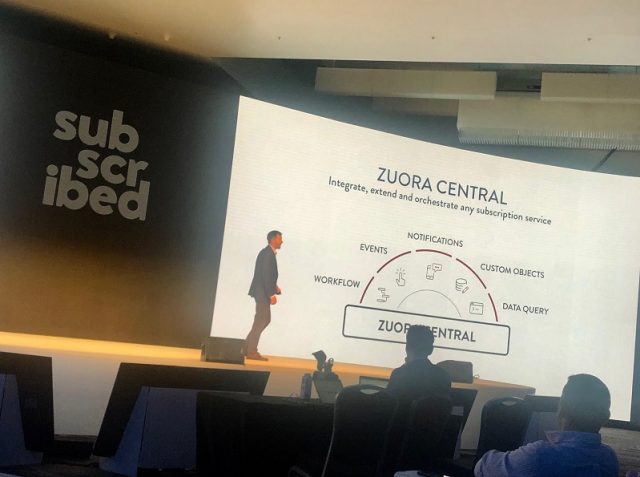Tien Tzuo, Zuora Founder and CEO, pulled out his crystal ball to take a look into the future as he kicked off Subscribed 2019, our flagship user conference. Read on for highlights from Tien’s keynote with McKinsey; Fender; our Subscribed Institute Founder, Amy Konary; and Tom Krackeler and Mike Aaron, our SVP and VP of Products.
The future is….
SHOES!

Yes, shoes. Connected shoes, like the Under Armour Tzuo wore on his feet. Sneakers with built-in sensors that track and analyze every step. Linked to an app, users can see their gait, cadence, and other data. This obviously benefits the user (who gets valuable information about their activity habits), but it also offers a clear benefit to businesses as they finally get a view of how customers are actually using their products.
And once you have smart connected products like these sneaks, what do you need with dumb unconnected ones?!
Maybe that’s why Marie Kondo has become such a worldwide sensation. Her message has captured the zeitgeist as we’re all realizing that we don’t need so many things! We don’t want to deal with the clutter, the never-ending maintenance, and the declining value.
THE END OF OWNERSHIP
This realization is captured in a recent Harris Poll of 13,000 people across 12 countries. Of adults surveyed, 57% of people surveyed said they wished they could own less stuff. And 70% said subscriptions freed them from the burden of ownership. In fact, 74% believe that, in the future, people will subscribe to more services and own less physical goods.
So, in a world where people want to own less stuff, be free from the burdens of ownership, and subscribe world…what’s the answer? What replaces ownership?
THE RISE OF USERSHIP
USERSHIP, of course!
Usership is the ability to access anything you want, anytime you want, without owning stuff.

It’s access to services that offer us choices, services that know what we like and what we don’t, that meet our needs, services that connect us and deliver ongoing value. That’s what usership is all about.
The concept of usership started long ago with utilities and telecom companies. You never bought a switch or meter; you just accessed your service and paid for what you used.
Then usership spread, to software and high tech. Forget about purchasing servers and CDs and databases; now you can access all these things as a service.
And now usership is set to explode: cars are coming off the assembly line with a connection to the internet. massive industrial printing presses are internet connected, laundromats are being controlled by your phone.
Things are no longer just things. From watches to doorbells to ovens, desks to windows to shoes — everything is connected. They have sensors; they’re connected. They are alive!
In fact Gartner predicts that there will be 25 billion connected things in use by 2021, 25 billion smart, connected devices, that will become simply portals, into services that we can use.
Everywhere you look, ownership is being replaced by usership: consuming news on your phone instead of having a print paper delivered to your house, taking a Lyft instead of buying a new car — this concept of usership over ownership is gathering steam across industry after industry.
And this idea of usership, that’s the backbone of the Subscription Economy — and it’s the source of massive business growth.
THE BOOMING SUBSCRIPTION ECONOMY
That is why subscription companies have grown more than 300% in the past seven years. And that is why in the U.S., subscription businesses are growing on average 5X faster than the regular companies in the S&P 500.
And this trend isn’t limited to just North America. This same subscription growth is rampant across Europe and APAC.
MCKINSEY SUBSCRIPTION ECONOMY RESEARCH
McKinsey joined the Subscribed Institute to share their insights. They’re finding more and more of their clients are transitioning to subscription business models which offer unique benefits for their customers, their business, and their investors.
In order to receive those benefits, customers need to undertake a holistic transformation of their business systems.
It’s not just about how you price and package your offerings, how you develop your offerings, how you market them, how your engineering team works. It’s a holistic transformation to optimize your business for subscriptions.
Key findings from recent McKinsey research includes:
– Growth. Within Accounts or Number of Accounts. We looked at whether leaders should focus on growth by growing within existing accounts, or number of accounts. They found dramatic differences from B2B to B2C, and within sub-sectors. But the short answer is that growing within existing accounts is critical to B2B growth as companies scale whereas in the B2C context the concept of cross-selling remains illusory.
– Simplicity. They looked at the value of simplicity and found that companies with fewer rate plans and options can grow faster.
– Churn. They also looked at churn. You might think that longer subscription durations would reduce churn, but that’s not the case.
(Stay tuned for more joint research from McKinsey and the Subscribed Institute.)
FENDER: AT THE FOREFRONT OF USERSHIP
As Tien noted in the beginning of the keynote, the Subscribed community has always been ahead of the curve, leading the way, pointed to the future. Zuora customer Fender is a living example of this.

Two years ago at Subscribed, Andy Mooney, the CEO of Fender introduced us to this revolutionary new concept called Fender Play: their answer to Usership — because they knew that 90% of new guitarists quit within the first 90 days of owning a guitar.
Two years later, Ethan Kaplan, General Manager of Fender Digital, came on stage to share what’s happened since Fender Play launched. The results are a testament to the power of usership.
Since launch, Fender now has 100,000 subscribers, with 40% of active users signed up for a year’s tuition, and an almost 90% retention rate across all users.
As Kaplan notes, “Guitar is one of the hardest user interfaces ever created, so subscribers consuming these videos is a really good sign of usership.” (Check out highlights from our usership panel for more choice insights about Fender.) https://www.zuora.com/2019/06/04/rise-usership-subscribed-2019-customer-panel/
DRIVING USERSHIP = ENABLING CUSTOMER INTERACTIONS
The companies that are succeeding in this era of usership are the ones that are really good at driving customer interactions, monetizing services instead of things, and translating that growth into revenues.
But offering customers choices isn’t easy.
In fact, our data shows that for every single interaction, there are, on average, 15 downstream operations that your business needs to do. And managing all those downstream interactions doesn’t happen by accident. It takes a ton of work to manage all that complexity to make things simple for the customer.
Orchestrating subscriber interactions is complex. It’s overwhelming. It’s also critical to your success. If you do it well, your business will thrive. Do it badly, goodbye subscribers.
THE BSS/OSS MODEL: MONETIZATION + ORCHESTRATION
So how can you manage this complexity? Let’s look at how telcos do it. Telcos build a system they call BSS/OSS: BSS supports service monetization and OSS supports service orchestration. They spent billions and decades to build these customized systems on an archaic, hardcoded system.
As industry after industry makes this shift to services, what are they going to do? When auto companies spin up new connected services like telematics, how will they connect usage and inventory? How will they orchestrate disparate systems to work together?
What about media companies? Or healthcare? Manufacturing, aviation, retail, banking, and more?
Will they spend millions to build a solution, delaying time to market, and falling behind competitors?
ANNOUNCING THE ZUORA CENTRAL PLATFORM FOR ORCHESTRATION
Zuora already offers a market leading suite of applications for monetization. Our Billing, RevPro, CPQ, Collect, and Marketplace apps enable you to price and package, acquire and retain subscribers, send invoices and collect payments, and recognize revenue.
Today, we announced the Platform of the future to help subscription businesses to orchestrate their services.
We are no longer just an applications company; we’re a platform company — because the future isn’t just about monetization; it’s about orchestration.

The first generation of enterprise software was on premise, like Oracle and Siebel. Then came Gen 2 with companies like Salesforce and Netsuite which took on-prem software to the cloud. Now it’s time for the next generation of enterprise software with a whole different architecture for cloud services at scale.
We already see this with Google, Facebook, and Amazon. They are built on microservices architectures in which services operate independently. Not bogged down by a single monolithic architecture, they operate with massive speed and scalability.
That’s why we’re pleased to announce a major update to our Zuora Central Platform that we’ve been working on for three years, for massive scalability, unlimited extensibility, iron-clad security and reliability, and enabling rapid and continuous innovation.
Simply put, the new Central Platform will help you orchestrate all your subscription services, plus extend and integrate the applications you are already using
This means you can:
– Design subscriber flows for acquisition, upgrades, renewals, dunning
– Trigger calls to entitlements, provisioning, inventory systems
– Drive efficiencies across all your operations
– Orchestrate any process
– Listen for any event
– Call out to any endpoint or person
– Create any object model
– Access real-time data
ZUORA CENTRAL DEVELOPER PLATFORM
This is going to make a really positive impact with our customers – especially the developers and IT teams that we work with. We’re opening up our platform to give developers, customers, and partners a whole new way to extend, integrate, and orchestrate Zuora to fit their needs– to trigger provisioning, send customer communications, to connect multiple processes and systems that need to work together to create a compelling subscription experience.
Our brand new developer platform gives you all building blocks you need to implement any custom logic related to subscriptions.
OTHER ZUORA PRODUCT ANNOUNCEMENTS
Zuora SVP of Products Tom Krackeler and VP of Products Mike Aaron discussed other enhancements and new features and product offerings, including:
– Zuora Workflow: Create workflows to orchestrate financial operations and trigger external processes such as provisioning, data integrations, and communications.
– Custom Objects: Customize the Zuora object model to run a larger footprint of subscription operations and capture a broader set of data through Zuora.
– Events and Notifications: Listen for any event and then execute API callouts, notifications, and workflows.
– Data Queries: Create tailored queries to connect, query, and export data with the full richness of SQL.
– Zuora Labs: Brand new environment intended for developers, but open for anyone, to get early access to the latest bleeding edge product development, and give us feedback on Beta features in our Developer Community.
– Summer 2019 Product Release: Free trial of Workflow, new international capabilities in Zuora Billing, new disputes management module in Zuora Collect, Subscriber Portal Marketplace app, enabling self-serve account management and payments.
ZUORA CENTRAL JUST GOT “CENTRAL-ER”

But perhaps Product’s biggest announcement was about the Zuora Central platform.
In short…
To succeed in this new world there are two imperatives: monetize AND orchestrate services.
For the last ten years, Zuora has been known for its leading set of apps that help you monetize. With our major upgrade to the Zuora Central Platform, you now have the ability to orchestrate your services.
Learn more about Zuora Central.